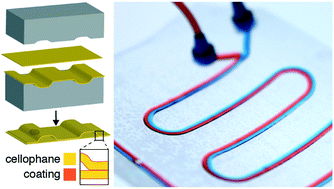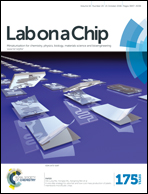Coated and uncoated cellophane as materials for microplates and open-channel microfluidics devices†
Abstract
This communication describes the use of uncoated cellophane (regenerated cellulose films) for the fabrication of microplates, and the use of coated cellophane for the fabrication of open-channel microfluidic devices. The microplates based on uncoated cellophane are particularly interesting for applications that require high transparency in the ultraviolet (UV) regime, and offer a low-cost alternative to expensive quartz-well plates. Uncoated cellophane is also resistant to damage by various solvents. The microfluidic devices, based on coated cellophane, can have features with dimensions as small as 500 μm, and complex, non-planar geometries. Electrodes can be printed on the surface of the coated cellophane, and embedded in microfluidic devices, to develop resistive heaters and electroanalytical devices for flow injection analysis, and continuous flow electrochemiluminescence (ECL) applications. These open-channel devices are appropriate for applications where optical transparency (especially in the visible regime), resistance to damage by water, biocompatibility and biodegradability are important. Cellophane microfluidic systems complement existing cellulose-based paper microfluidic systems, and provide an alternative to other materials used in microfluidics, such as synthetic polymers or glass. Cellulose films are plausible materials for uses in integrated microfluidic systems for diagnostics, analyses, cell-culture, and MEMS.


 Please wait while we load your content...
Please wait while we load your content...